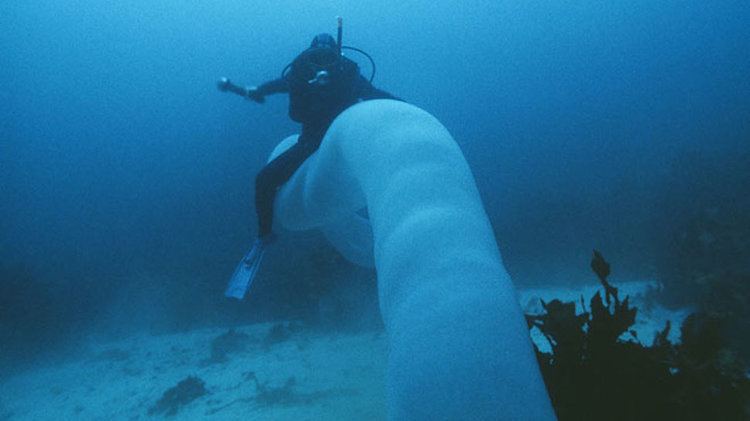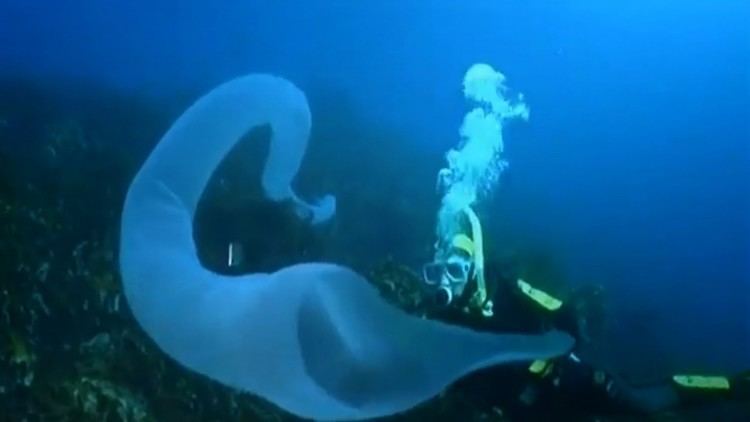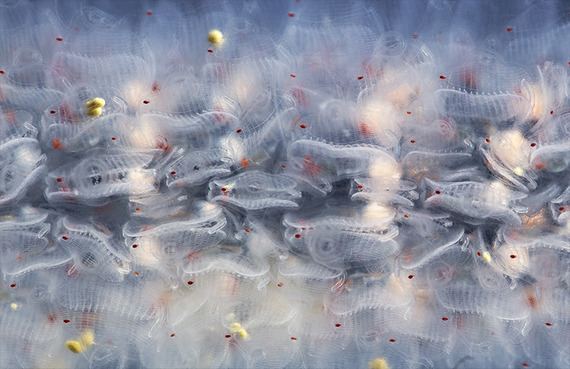Order Pyrosomida Scientific name Pyrosoma | Family Pyrosomatidae Higher classification Pyrosomatidae | |
 | ||
Similar Salp, Thaliacea, Tunicate, Pyrosoma atlanticum, Doliolida | ||
Giant pyrosome and salps pelagic sea squirts
Pyrosomes, genus Pyrosoma, are free-floating colonial tunicates that live usually in the upper layers of the open ocean in warm seas, although some may be found at greater depths. Pyrosomes are cylindrical or cone-shaped Colonies made up of hundreds to thousands of individuals, known as zooids. Colonies range in size from less than one centimeter to several metres in length.
Contents
- Giant pyrosome and salps pelagic sea squirts
- Pyrosomes and squid eggs
- Bioluminescence
- Species
- References

Each zooid is only a few millimetres in size, but is embedded in a common gelatinous tunic that joins all of the individuals. Each zooid opens both to the inside and outside of the "tube", drawing in ocean water from the outside to its internal filtering mesh called the branchial basket, extracting the microscopic plant cells on which it feeds, and then expelling the filtered water to the inside of the cylinder of the colony. The colony is bumpy on the outside, each bump representing a single zooid, but nearly smooth, though perforated with holes for each zooid, on the inside.

Pyrosomes are planktonic, which means their movements are largely controlled by currents, tides, and waves in the oceans. On a smaller scale, however, each colony can move itself slowly by the process of jet propulsion, created by the coordinated beating of cilia in the branchial baskets of all the zooids, which also create feeding currents.

Pyrosomes are brightly bioluminescent, flashing a pale blue-green light that can be seen for many tens of metres. The name Pyrosoma comes from the Greek (pyro = "fire", soma = "body"). Pyrosomes are closely related to salps, and are sometimes called "fire salps". Sailors on the ocean are occasionally treated to calm seas containing many pyrosomes, all luminescing on a dark night.

Pyrosomes and squid eggs
Bioluminescence
Although many planktonic organisms are bioluminescent, pyrosome bioluminescence is unusual in its brilliance and sustained light emission, and evoked the following comment when seen by scientist T.H. Huxley at sea:
"I have just watched the moon set in all her glory, and looked at those lesser moons, the beautiful Pyrosoma, shining like white-hot cylinders in the water" (T.H. Huxley, 1849).
Pyrosomes display a fascinating behavior where waves of light travel throughout the colony, triggered as each individual zooid senses light and subsequently emits light in response. These zooids have a pair of luminescent organs close to the external surface of their tunic. These organs are filled with luminescent organelles, which are thought to possibly consist of intracellular bioluminescent bacteria, contributing to the pyrosome's unique bioluminescent display. The waves of bioluminescence that move within a colony are apparently not propagated through neurons, but by a photic process. Flashing zooids not only stimulate other zooids within the colony to bioluminesce, but nearby colonies will also display bioluminescence in response. Colonies bioluminesce in response to mechanical stimulation (touch), as well as to light.
Species
The following species are accepted as valid by the World Register of Marine Species:
